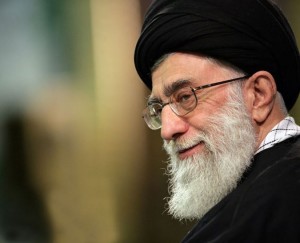Iran says it doesn’t want a nuclear bomb and Western intelligence agencies say it isn’t building one, but Israeli leaders and their U.S. supporters say a preemptive strike may still be necessary. A key argument is the threat of a regional arms race, a claim that ex-CIA analyst Paul R. Pillar finds dubious.
By Paul R. Pillar
There are two main pieces of conventional wisdom, widely held but almost never examined, about the regional effects of an Iranian nuclear weapon.
One is that possession of a nuke would make Iran significantly more aggressive and troublesome in the Middle East, a notion that does not stand up to scrutinyof Iran’s calculations and motivations or those of its neighbors.

Iran's Supreme Leader Ali Khamenei, who has denounced nuclear weapons as a great sin. (Photo credit: sajed.ir)
The other is that the advent of an Iranian weapon would trigger a wave of further nuclear proliferation in the region. Steven Cook has provided a good corrective to this second bit conventional wisdom.
Cook examines the capabilities and likely intentions of the most probable proliferators, Turkey, Egypt and Saudi Arabia, and finds none of them are plausible candidates to be the next proud owner of a nuclear weapon, regardless of any concerns about Iran.
None of them has the technology and infrastructure to make a nuclear-weapons program feasible in the foreseeable future, and each would have to worry about reactions of the international community and especially of the United States.
The idea of a near-certain spread of nuclear weapons has partly been talked up by those having other reasons to agitate about the dangers of an Iranian nuke. But the notion also is grounded in a habitual American way of looking at foreign threats (and foreign opportunities), which is to apply spatial imagery and assume the geographic spread of a phenomenon from one neighboring country to another.
This outlook was a basis for different domino theories, including the one that according to neoconservatives would see democracy spread from a Saddam-less Iraq to other Arab states.
Another famous domino theory undergirded U.S. military intervention in Vietnam in the 1960s: the idea that the fall of South Vietnam to communism would lead a succession of Asian neighbors to fall as well.
That earlier domino theory was consistent with an alternative Cold War visual imagery of red paint oozing over the globe, which also happened to look like the well-known logo of a major paint company. The idea of a rapid proliferation of nuclear weapons in the Middle East is just the latest manifestation of the Sherwin-Williams theory of international relations.
If the leaders of would-be proliferator states were to carefully consider what nuclear weapons could and could not do for them, they would have other reasons, in addition to those Cook discusses, for not attempting to acquire such weapons even if a beleaguered Iran decided to do so. There simply are not a lot of useful things you can do with nukes.
As Zeev Maoz argued in an article several years ago, nuclear weapons may not even have enhanced the security of the sole Middle Eastern state, Israel, that has had the weapons and had them for decades.
If we can get away from narrow, scared-chicken fixation on the supposed threat from any one possible bit of nuclear proliferation and instead let more sober calculations prevail, the long-discussed concept of a Middle East nuclear-weapons-free zone would become feasible.
Paul R. Pillar, in his 28 years at the Central Intelligence Agency, rose to be one of the agency’s top analysts. He is now a visiting professor at Georgetown University for security studies. (This article first appeared as blog post at The National Interest’s Web site. Reprinted with author’s permission.)
